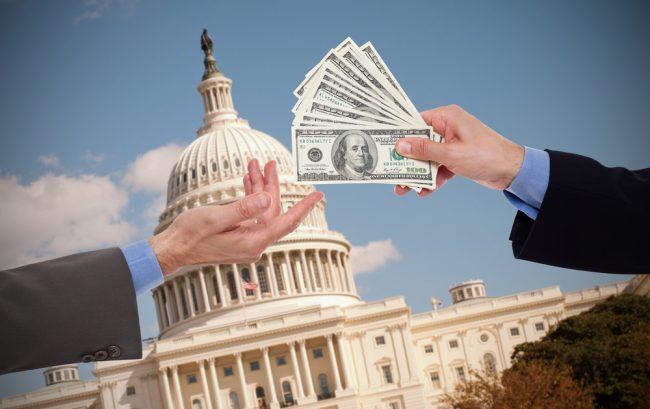 Political donation
Political donation
The political money machine is like an ATM.
It never shuts down.
Recommended For You
This year isn't a congressional election year, but members of Congress are still amassing their war chests. And political action committees, ranging from one representing Major League baseball to a bunch representing credit unions and banks, are helping them do it.
The latest campaign finance reports for the 2019 to 2020 campaign cycle were filed in August and covered the first seven months of the year.
By that date, CUNA's political action committee, CULAC, had contributed almost $1.1 million to candidates for the House and Senate, and party committees in each House and party, this year.
That compares to contributions of about $1 million by the end of July 2017 for the 2017 to 2018 campaign cycle.
If you're not confused by the months, the amounts and the campaign cycles, keep reading.
If you are confused, well … NAFCU operates a much smaller political action committee.
By the end of July, NAFCU had contributed $96,500 to the political campaigns.
By July 2017, NAFCU had dolled out $121,000 in campaign contributions.
Now let's turn to your friends, the bankers. (That was sarcasm, by the way, lest you think I don't know what you folks really think of bankers.)
By the end of July, the American Bankers Association had contributed $1.3 million to congressional candidates. During the last election cycle, the ABA had contributed about $715,000 by the end of July 2017.
And finally, there's the Independent Community Bankers of America. Those folks had contributed $459,000 by the end of July, compared with about $584,000 by the end of July 2017.
A large percentage of the money forked over by the bank and credit union political action committees go to members of congressional committees with jurisdiction over financial services.
That just makes sense. You contribute money to the folks who can most directly help or hurt you.
The folks at the Center for Responsive Politics crunched the campaign finance report figures and came up with fantastic analyses about who gives to whom. For instance, the credit union industry contributed $593,702 to members of the House Financial Services Committee during the 2018 election cycle. That averages out to $9,895 per committee member.
As a comparison, the credit union industry contributed an average of $1,364 to all House members.
Credit union trade groups are also more bipartisan in their contributions than the banking trade groups.
CUNA's political committee thus far has contributed 51% to Republicans during the current election cycle and 48% to Democrats.
NAFCU's committee has contributed 59% of its money to Republicans and 41% to Democrats.
The ABA has so far contributed 71% of its money to Republicans and 29% to Democrats.
And the ICBA committee has contributed 62% to Republicans and 38% to Democrats.
Of course, this is just the start. If the past is any indication, the ATM will keep humming between now and Nov. 3, 2020.
An Honor He May Not Like
A shadowy website, explorecreditunions.com, has been hounding credit unions for more than a year.
Earlier this month, CU Times reported that while the site's registration had been completed by a proxy, one day it identified the registration as belonging to the ABA.
Shortly after CU Times contacted the trade group, the website was taken down, although the ABA said there was no connection between the two.
But the site's Facebook page and Twitter feed continued to operate, and after a week, the website reappeared, with the ABA's ownership disclosed.
And while the site was filled with anti-credit union rhetoric, it did praise one person.
"A surprise hero has emerged from a recent NCUA board meeting as the new voice of reason: Board Member Todd Harper," the explorecreditunions.com Facebook page said.
One can only assume that the bankers appreciated Harper for grilling NCUA staff on such issues as the agency's Risk-Based Capital rule.
But the link from the Facebook page to the story on the website was broken, so we may never know.
Gardner and Grass Redux
There's been some speculation that marijuana banking legislation in the Senate might be tied to the reelection efforts of Sen. Cory Gardner (R-Colo.).
Gardner long has been considered one of the most endangered Senate Republicans. He is also one of the lead sponsors of marijuana banking legislation in the Senate.
Marijuana is legal in Colorado, and the thought was that if Gardner could push the legislation through the Senate, he would be considered a hero back home.
The House Financial Services Committee has approved its version of the bill, and while it hasn't been taken to the floor yet, it has 206 co-sponsors in the House, so its passage is likely.
Well, Gardner's reelection became even more iffy recently when former Colorado Gov. John Hickenlooper abandoned his campaign for the Democratic presidential nomination and decided to seek the Democratic nomination to oppose Gardner.
At least one Democrat has abandoned his effort to seek that nomination and Hickenlooper is considered the favorite to capture the nod.
He's considered to be the party's best chance to flip the Senate seat.
Would Senate Majority Leader Mitch McConnell (R-Ky.) allow the cannabis banking legislation to advance in an effort to bolster the Gardner campaign?
McConnell is impossible to predict (his dour look never seems to change), but if he thinks that the Colorado Senate seat is vital to keeping the Republican majority in the Senate, he just might allow the bill to advance.
 David Baumann
David Baumann David Baumann is a correspondent-at-large for CU Times. He can be reached at [email protected].
© Touchpoint Markets, All Rights Reserved. Request academic re-use from www.copyright.com. All other uses, submit a request to [email protected]. For more inforrmation visit Asset & Logo Licensing.






